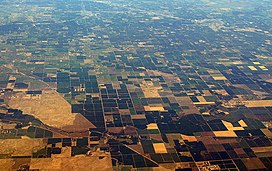| Central Valley | |
|---|---|
| Great Central Valley, Great Valley, Golden Empire | |
 Farmland of the Central Valley as seen from the air | |
 United States Geological Survey map of their defined four major regions of the Central Valley | |
| Length | 450 mi (720 km) |
| Width | 40 to 60 mi (64 to 97 km) |
| Area | 18,000 sq mi (47,000 km2)[1] |
| Depth | 2,000 to 6,000 ft (610 to 1,830 m) |
| Geology | |
| Type | Alluvial |
| Age | 2–3 million years |
| Geography | |
| Location | California, United States |
| Population centers | Sacramento, Fresno, Bakersfield, Stockton and Modesto |
| Borders on | Sierra Nevada (east), Cascade Range, Klamath Mountains (north), Coast Range, San Francisco Bay (west) and Tehachapi Mountains (south) |
| Coordinates | 37°00′N 120°18′W / 37°N 120.3°W[2] |
| Traversed by | Interstate 5, Interstate 80 and State Route 99 |
| Rivers | Sacramento River, San Joaquin River and Kings River |
The Central Valley is a broad, elongated, flat valley that dominates the interior of California. It is 40–60 mi (60–100 km) wide and runs approximately 450 mi (720 km) from north-northwest to south-southeast, inland from and parallel to the Pacific coast of the state. It covers approximately 18,000 sq mi (47,000 km2),[1] about 11% of California's land area. The valley is bounded by the Coast Ranges to the west and the Sierra Nevada to the east.
The Central Valley is a region known for its agricultural productivity. It provides a large share of the food produced in California. California provides more than half of the fruits, vegetables, and nuts grown in the United States.[3] More than 7,000,000 acres (28,000 km2) of the valley are irrigated via reservoirs and canals.[4] The valley hosts many cities, including the state capital Sacramento, as well as Redding, Chico, Stockton, Modesto, Merced, Fresno, Visalia, Porterville, and Bakersfield.
The Central Valley watershed comprises 60,000 square miles (160,000 km2), or over a third of California. It consists of three main drainage systems: the Sacramento Valley in the north, which receives over 20 inches (510 mm) of rain annually; the drier San Joaquin Valley in the south, and the Tulare Basin and its semi-arid desert climate at the southernmost end. The Sacramento and San Joaquin river systems drain their respective valleys and meet to form the Sacramento–San Joaquin River Delta, a large expanse of interconnected canals, stream beds, sloughs, marshes and peat islands. The delta empties into the San Francisco Bay, and ultimately into the Pacific.[5] The waters of the Tulare Basin essentially never reach the ocean (with the exception of Kings River waters diverted northward for irrigation), though they are connected by man-made canals to the San Joaquin.
The valley encompasses all or parts of 18 California counties: Butte, Colusa, Glenn, Fresno, Kern, Kings, Madera, Merced, Placer, San Joaquin, Sacramento, Shasta, Stanislaus, Sutter, Tehama, Tulare, Yolo and Yuba.[6]
- ^ a b "California Central Valley". American Museum of Natural History. Archived from the original on October 29, 2016.
- ^ "Central Valley". Geographic Names Information System. United States Geological Survey, United States Department of the Interior.
- ^ "California's Central Valley: Producing America's Fruits and Vegetables". House Committee on Natural Resources. Archived from the original on June 23, 2015. Retrieved May 15, 2017.
- ^ "Federal Agencies Release Data Showing California Central Valley Idle Farmland Doubling During Drought". landsat.gsfc.nasa.gov. October 21, 2015. Archived from the original on April 10, 2016.
- ^ Bittman, Mark (October 10, 2012). "Everyone Eats There". The New York Times. Archived from the original on October 13, 2012. Retrieved October 10, 2012.
Central Valley, which is two valleys: the San Joaquin to the south and Sacramento to the north. All told,[ sic] the Central Valley is about 450 miles long, from Bakersfield up to Redding, and is 60 miles at its widest, between the Sierra Nevada to the east and the Coast Ranges to the west.
- ^ Cite error: The named reference
overviewwas invoked but never defined (see the help page).